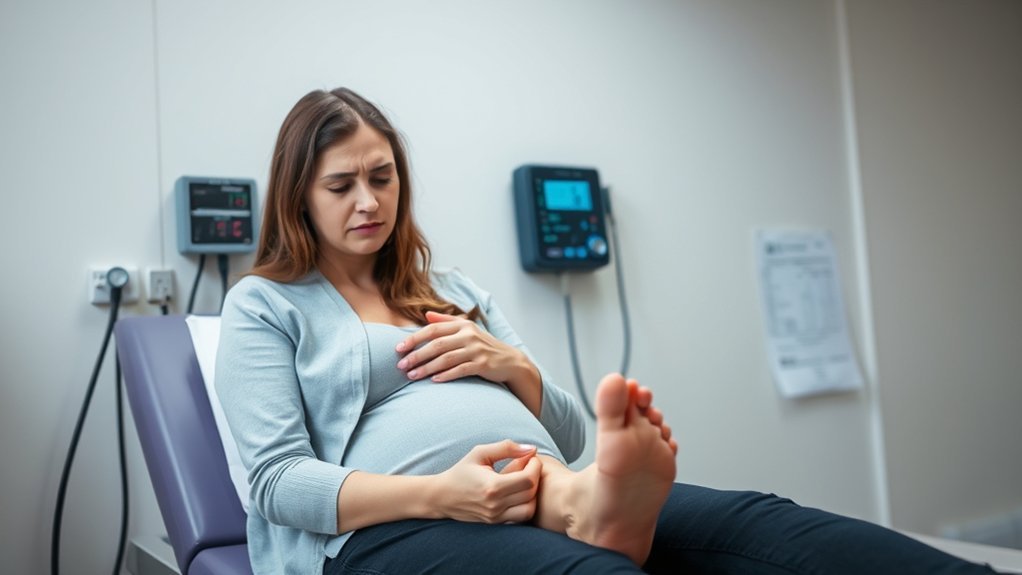Imagine a woman in her late thirties, expecting her first child, who suddenly develops severe headaches and noticeable swelling in her legs. These symptoms could indicate preeclampsia, a condition that poses serious risks during pregnancy. Understanding the signs, causes, and risk factors associated with this complication is essential for every expecting mother. What should you know to guarantee both your health and your baby’s well-being?
Understanding Preeclampsia: Definition and Overview

Preeclampsia is a pregnancy-related condition characterized by high blood pressure and signs of damage to other organ systems, often the kidneys. It typically occurs after the 20th week of pregnancy and can affect both you and your baby.
If left untreated, preeclampsia can progress to more severe complications, such as eclampsia or HELLP syndrome. The exact cause remains unclear, but it’s believed to involve issues with blood vessels and the placenta.
Your risk factors may include a history of preeclampsia, chronic hypertension, or certain pre-existing conditions. Regular prenatal check-ups are essential for monitoring your blood pressure and overall health during pregnancy.
Early detection and management can greatly reduce risks for both you and your baby.
Common Signs and Symptoms of Preeclampsia

As you monitor your health during pregnancy, it’s essential to recognize the common signs and symptoms of preeclampsia.
Elevated blood pressure and significant swelling, especially in the hands and face, can indicate this serious condition.
Staying informed about these indicators can help guarantee timely medical intervention.
High Blood Pressure Indicators
High blood pressure is a key indicator of preeclampsia, often emerging after the 20th week of pregnancy.
You should monitor your blood pressure regularly, as readings of 140/90 mmHg or higher may signal a problem. Elevated blood pressure can lead to reduced blood flow to essential organs, affecting both you and your baby.
Along with high blood pressure, you might experience headaches, visual disturbances, or sudden abdominal pain, which can indicate worsening symptoms. It’s important to report any of these signs to your healthcare provider promptly.
Early detection and management can help mitigate risks associated with preeclampsia, ensuring better outcomes for you and your baby. Always keep your prenatal appointments and discuss any concerns with your doctor.
Swelling and Fluid Retention
Swelling, particularly in the hands and face, is a common sign of preeclampsia that can occur alongside high blood pressure. This fluid retention is a result of changes in your body during pregnancy, but when it becomes excessive, it raises concern.
You should monitor your symptoms closely, as they may indicate the need for medical evaluation. Key features of swelling in preeclampsia include:
- Sudden onset of swelling, especially in the face
- Swelling of hands, feet, or ankles
- Accompanied by headaches or visual disturbances
- Rapid weight gain due to fluid retention
If you notice these signs, it’s essential to consult your healthcare provider for further assessment and management.
Early detection can help prevent complications for both you and your baby.
The Importance of Early Detection

Early detection of preeclampsia is essential for maternal and fetal health.
By recognizing symptoms promptly and monitoring your blood pressure regularly, you can greatly reduce the risks associated with this condition.
Timely intervention can lead to better outcomes for both you and your baby.
Recognizing Symptoms Early
How can recognizing the symptoms of preeclampsia early impact your health and that of your baby? Early detection is essential in managing preeclampsia since it can lead to serious complications if left untreated.
By identifying symptoms promptly, you can guarantee timely medical intervention, reducing risks for both you and your baby.
Consider these key symptoms to watch for:
- Persistent headaches that don’t go away with usual relief methods
- Sudden swelling in your face, hands, or feet
- Changes in vision, such as blurriness or seeing spots
- Upper abdominal pain, particularly under the ribs
Being vigilant about these signs allows for proactive healthcare decisions, ultimately supporting better outcomes during your pregnancy.
Monitoring Blood Pressure Regularly
Regularly monitoring your blood pressure is essential during pregnancy, as it can help detect preeclampsia before it escalates into serious health issues. Elevated blood pressure is one of the primary indicators of this condition, and early identification is important for effective management.
You should check your blood pressure at home and attend all scheduled prenatal appointments, where healthcare providers will also assess your levels. If you notice any significant changes or symptoms, like headaches or swelling, report them immediately.
Consistent monitoring allows for timely interventions, reducing risks for both you and your baby. Remember, proactive management of your blood pressure can lead to better outcomes and a healthier pregnancy experience overall.
Causes of Preeclampsia
Preeclampsia arises from a complex interplay of genetic, environmental, and physiological factors. Understanding these causes can help you recognize the condition early.
Preeclampsia results from a mix of genetic, environmental, and physiological factors, highlighting the importance of early recognition.
Here are some key contributors:
- Genetic predisposition: Family history of preeclampsia increases your risk.
- Placental abnormalities: Issues with placental development can lead to improper blood flow.
- Immune system response: An abnormal response of your immune system to the placenta may trigger preeclampsia.
- Vascular factors: Impaired blood vessel function can cause elevated blood pressure and organ dysfunction.
Identifying Risk Factors for Preeclampsia
While understanding the signs of preeclampsia is essential, identifying risk factors can greatly enhance your ability to anticipate and manage the condition. Several factors increase your risk, including a history of hypertension, obesity, and diabetes.
If you’re carrying more than one fetus or have a family history of preeclampsia, you’re also at heightened risk. Age plays a role; women under 20 or over 35 may face increased susceptibility.
Additionally, if you’ve experienced preeclampsia in a previous pregnancy, your chances of recurrence rise. It’s vital to discuss these factors with your healthcare provider to monitor your health closely during pregnancy.
Recognizing these risk factors allows for proactive measures to safeguard both you and your baby.
Managing and Treating Preeclampsia
When managing and treating preeclampsia, it’s vital to prioritize both maternal and fetal health. Your healthcare provider will closely monitor your condition through regular check-ups and may recommend several interventions depending on the severity of your symptoms.
- Medication: Antihypertensive drugs can help manage high blood pressure.
- Bed Rest: Reducing physical activity may alleviate stress on your body.
- Monitoring: Frequent assessments of blood pressure, kidney function, and fetal well-being are important.
- Delivery: In severe cases, early delivery may be necessary to protect both you and your baby.
Always follow your healthcare provider’s recommendations and report any worsening symptoms immediately.
Prioritize your health by adhering to your provider’s advice and promptly reporting any concerning symptoms.
Early intervention can greatly improve outcomes for both you and your child.
Support and Resources for Expecting Mothers
Expecting mothers facing the challenges of conditions like preeclampsia can benefit greatly from a strong support system and access to reliable resources. Connecting with healthcare providers is essential; they can offer tailored advice and monitoring.
Joining support groups, whether in-person or online, allows you to share experiences and gain insights from others in similar situations. Educational resources, such as pamphlets, websites, and webinars, can enhance your understanding of preeclampsia, empowering you to make informed decisions.
Additionally, consider enlisting the help of family and friends for emotional support and practical assistance. Remember, maintaining open communication with your healthcare team and loved ones can alleviate anxiety and promote a healthier pregnancy experience.
Utilize these resources to navigate your journey effectively.
Frequently Asked Questions
Can Preeclampsia Occur in Subsequent Pregnancies?
Yes, preeclampsia can occur in subsequent pregnancies. If you’ve had it before, your risk increases in future pregnancies. It’s crucial to monitor your health closely and work with your healthcare provider for ideal outcomes.
What Lifestyle Changes Can Help Reduce the Risk?
To reduce your risk, maintain a healthy weight, exercise regularly, manage stress, eat a balanced diet rich in fruits and vegetables, and avoid smoking and excessive alcohol. Regular prenatal check-ups are essential for monitoring health.
How Does Preeclampsia Affect the Baby?
Preeclampsia poses potential peril for your baby, possibly leading to problems like preterm birth, low birth weight, or developmental delays. It’s essential to monitor your health closely during pregnancy to protect your child’s well-being.
Are There Any Long-Term Effects of Preeclampsia?
Yes, there can be long-term effects of preeclampsia, including increased risk of cardiovascular diseases and kidney issues. You should monitor your health closely post-pregnancy, as early intervention may mitigate potential complications.
What Is the Difference Between Preeclampsia and Eclampsia?
“Better safe than sorry,” preeclampsia involves high blood pressure and potential organ damage, while eclampsia includes seizures resulting from untreated preeclampsia. Recognizing these differences is essential for effective management and prevention of complications.
Conclusion
In the journey of pregnancy, being aware of preeclampsia’s signs and risk factors is vital for your safety and your baby’s well-being. Like a lighthouse guiding ships through foggy waters, early detection can help navigate potential complications. By understanding the symptoms and seeking timely medical care, you can guarantee a smoother path ahead. Stay informed, vigilant, and proactive—your health and the health of your child depend on it.
